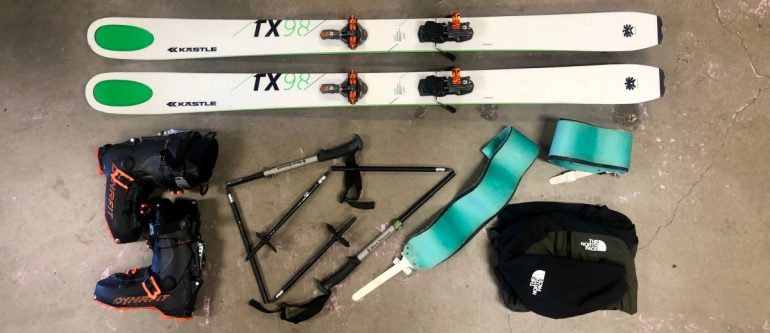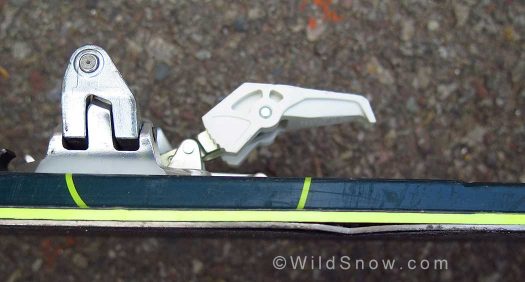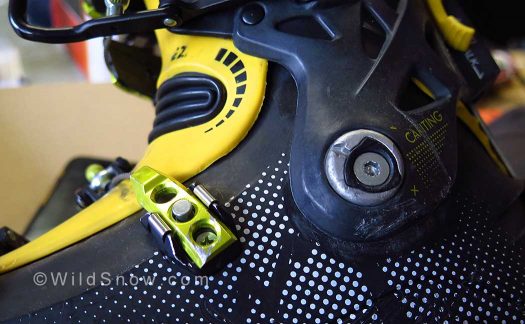
While it’s easy to grab your skis, poles, boots and skins without a second thought, a little gear check in now will go a long way come winter.
Now — not in the middle of a hut trip in February — is a great time to give your gear the TLC needed to help it perform flawlessly through another season. In this post, we revamp our classic pre-season gear check with feedback from readers and a WildSnow Pre-season Gear Checklist you can even print and gorilla glue to your garage ski bench. Don’t let this be the season when you’re That Guy whose binding screws just happened to worm out of their sockets while you were charging up that next lap deep in the backcountry.
“I was just skiing along and. . .” disaster. A morning full of excitement of the much anticipated earning of turns is thwarted by a faulty piece of equipment that leaves you cursing at the trailhead or sends you home early.
Ski touring gear is expensive and much is built to be so minimalist and lightweight that we are asking for problems if we don’t treat it with some tender love and care. You wouldn’t drive a brand new car off the lot and expect it to perform flawlessly over the years without some oil changes, part replacement and attention to detail. Hopefully, by paying attention to your gear and performing simple checks a few times a season, you can catch malfunctions before smoke starts billowing from under the hood.
Throughout my years of ski shop work, I have seen hundreds of sudden failures, both on customers’ gear and even my own. The problems often seem to come out of nowhere, when just the day before your gear looked shiny and eager to propel you up and down the mountains. But this stuff doesn’t really come out of the great mysteries of the universe. Most often, there are warning signs. To that end, how about a checklist? (Please note, below is oriented to tech bindings, but the concepts apply to frame binding systems as well.)
Bindings
We ask a lot of ski bindings whose weight has now dipped under 200 grams and yet still firmly hold you to your skis. Speeds of up to 50 mph and variable and snow condition can now be skied, but the margin for error in your gear is smaller than ever.
__Check all binding mounting screws. If screws are loose, back them all the way out and add wood glue or epoxy to the hole and tighten back down. In Lou’s opinion, epoxy is better in this situation, but wood glue does work.
__Make sure binding is completely flat to ski, not “screw jacked.” This is a common problem and leads to all sorts of failures.
__Check for cracks, especially in the heel piece of binding, but examine the metallic toe plate as well (use a magnifying glass or 2x reading glasses).
__Check all machine screws for tightness. If a screw has backed out add Loctite and tighten down. These screw heads can be easy to strip so pay attention and go easy when retightening. If you’ve never done this and feel uncomfortable with it, seek the services of a professional binding technician.
__Click both boots into bindings and check heel spacing. There is nothing worse than getting the top of a ski line and realizing a friend was the last to use your gear in the spring
Skis
Skis vary immensely in strength and durability. Yet common to all, the stress they endure is amazing — and breakage isn’t exactly rare. Catching an issue before you ski it gives you a chance to repair or retire a ski before catastrophic failure.
__Examine skis for delaminations in top sheet and sidewalls. If you find cracks, add epoxy and clamp with medium tightness before water has a chance to permeate the core.
__Examine bases for dimples or core shots. Fill core shots with P-tex. If core shots are large (over a cm wide) you may want to visit a shop for a more serious repair.
__Check bases for wax. If the base looks white or dry it is time for wax. This is essential for backcountry skiers to avoid dry bases pulling off skin glue.
Skins
Does the state of your climbing skins reflect your personality, or just how busy you are? If you can tell the color of your dog’s hair from looking at your skins, or they’ve been cursed at so much they seem to curl up on their own, time to look at how they’re treated.
__Check skin glue for balling and general stickiness. Adding a little glue can help you scrape through a season and prevent you from wallowing in the backcountry. New “glueless” skins like the Tipon from Pomoca can be cleaned fairly effectively.
__Check tip and tail attachment on skins. Make sure all parts and pieces are there and in good condition. Watch for little tears around attachments that could start growing.
__Organize skins. If you use multiple setups and find yourself pawing through a pile of skins in the morning before a trip, perhaps it’s time to figure out a storage system. A simple approach is to have a dedicated bag for each set of skins, with the ski designation written on it.
Poles
__Check pole baskets to make sure they are firmly secure
__Inspect shaft for cracks.
__If you’ve got pole straps that are hard to adjust or broken, now is the time for a swap.
Boots
Sometimes, ski boots just seem to charge along for years with nary a problem. But. Especially when it comes to the boot being a key part of the binding due to tech fittings, attention to detail is vital for performance and safety.
__Check those machine screws again and add Loctite. A loose buckle can become a missing buckle if these are not routinely checked.
__Add a small coat of white lithium grease to the ski/walk mechanism to prevent it from sticking in one mode or the other.
__Overly worn cuff pivot rivet: check by manipulating cuff to see if there is excess play. Tips for rivet repair here. And don’t forget the Ultimate Cuff Pivot for your Dynafits. These are not exactly the easiest DIY projects but can be done at home. Any fairly active and reputable ski touring shop has probably installed a few.
__Check tech heel fitting to make sure it’s firmly fixed to boot. Tighten screws, remove and bed in J-B Weld if needed.
__Check boot function in several different new tech bindings, especially by doing a hand check of lateral release. If boot behaves poorly in a variety of new bindings, it’s possible the tech fittings are worn.
Beacon
Your beacon needs maintenance also. Check out our full post on pre-season beacon checks.
Miscellany
Of course, technical gear isn’t the only thing that needs TLC. Your soft goods probably could use some love too. Consider a DWR refresher wash on your shell jacket and pants, along with some mink oil or other leather proofing on your gloves. Has your down jacket been encased in a stuff sack all summer? Now’s a good time to air it out and maybe toss it in the wash too. Do your goggle lenses look like they’ve survived passage through a war zone? Could be time for an upgrade, or at least a lens switch up. And if your helmet is more than five years old, shows obvious cracking or has sustained some blows, it could be a good time to retire it.
Stay tuned in the coming weeks for a full pre-season beacon post and rundown of essential repair kit parts, both for humans and gear. And feel free to add your two cents in the comments below.
Doug Stenclik is an avid skimo racer and ski mountaineer who lives for sharing the amazing sports of ski touring and splitboarding. Since his first time on skins he was hooked and the obsession has taken him all over the United States and the world pursuing the human powered ski turn. He founded Cripple Creek Backcountry in 2012 and took over the Colorado Ski Mountaineering Race Cup in 2014 to spread knowledge and the love of the sport. In 2019 he took a step back from the ski shop and race promoter life to become a publishing partner with WildSnow.


